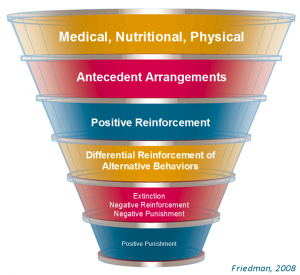Using only positive reinforcement seems like the right thing to do, however telling anyone that is what they should do is possibly setting them up for failure by taking tools off the table that in some circumstances may be required. The world is just not built that way; nor are animals “wired” to operate that way. Aversive stimuli abound in nature and all animals encounter them and learn to avoid them. What I would like to discuss here is a more practical, more achievable goal that will yield results without significantly adversely affecting the relationship between you and your bird.
If you visit my Behavior and Training web site you will notice that the banner for each page has a subtitle – “Where least intrusive becomes most effective,” that subtitle is so much more than simply a way to catch your attention, it is a reference to the most ethical way of choosing the strategy used for behavior change and training. The maxim “least intrusive” embodies important principles that as animal caretakers we should follow as closely as possible. Just as in the field of medicine the Hippocratic principle of doing no harm is the basis for the decisions our doctors make when they plan an intervention to correct health issues, we as animal caretakers should adopt a similar principle, that of choosing the least intrusive strategy for behavior change and training.
Those who have read my articles before may look at this proposed principle and recognize a construct. I can hear the questions now, “What does least intrusive look like?” If you are asking that question then you are well on the way to understanding behavior science. However, constructs are useful provided that they are defined and well understood by those who use them, so let’s take a closer look at our adage “least intrusive.”
Dr Susan Friedman published an article in GoodBird magazine in December 2009 that defined intrusiveness by these two criteria:
- The level of social acceptability.
- The degree to which the learner maintains control while the intervention is in effect.
While the level of social acceptability is a highly personal, ethical judgment, research shows that not only psychologists but also teachers, parents, and children place positive reinforcement strategies ahead of punishment based procedures when considering acceptability. In addition, punishment-based procedures have considerable fall-out, the subject of a future article.
Research into the effects of a learner’s control of outcomes shows that when control is removed and the ability to escape aversive stimuli is removed they give up trying to escape. This effect, known as learned helplessness, has been observed in a wide range of species and it often persists even when control is returned. To the greatest extent possible we must empower our birds to be able to use their behavior to control outcomes. This is the function of behavior, to operate on the environment to affect outcomes. A failure to recognize this and the removal of such control may result in one or more undesirable behaviors such as feather picking, unacceptable vocalizations, etc.
I hope that by reading the definition of least intrusive you will recognize that the effectiveness of a strategy is simply not enough. The intrusiveness of the procedure must also be considered. To guide us and to set a standard by which we can judge our techniques Dr Susan Friedman has proposed a hierarchy of procedural alternatives. Below you will see a graphic that shows the strategy hierarchy proposed by Dr Friedman in an article that was first published in GoodBird magazine (Vol 4-1; Winter 2009) that this article is based upon and rather than repeat or paraphrase her information here I strongly encourage you all to read “What’s wrong with this picture? Effectiveness is not enough.”

To return to the original theme of this article, the statement that only positive reinforcement should be used, I would like to change this. Rather than adopting what may well prove to be an impossible or even impractical goal we should set ourselves up for success with our birds with the goal of maintaining the highest possible ratio of positive reinforcement strategies to other more intrusive strategies. Certainly, when considering a strategy for behavior change we should start at the top of the above hierarchy and only proceed to a lower level when we have exhausted the options at the current level. Also note that before we begin to consider positive reinforcement strategies we have two levels of intervention available to us. Attempting to apply a positive reinforcement strategy to address a behavioral issue that has medical/physical roots does not make sense, nor does it address the needs of the bird.
In applying the least invasive strategy we will begin to build what Steve Martin calls a “trust account” with our birds in his article “It’s about relationships.” Our goal is to make the maximum number of deposits into that trust account using the strategies from the top of the hierarchy down to positive reinforcement. By keeping these deposits high in number our occasional need and application of lower level strategies will make withdrawals from that account but should nowhere near deplete the account. So let’s not be “Positive Reinforcement Trainers” let’s be “Most Positive, Least Intrusive Trainers.” Our birds will really appreciate it!
Sid.
 avianambassadors
avianambassadors com
com



